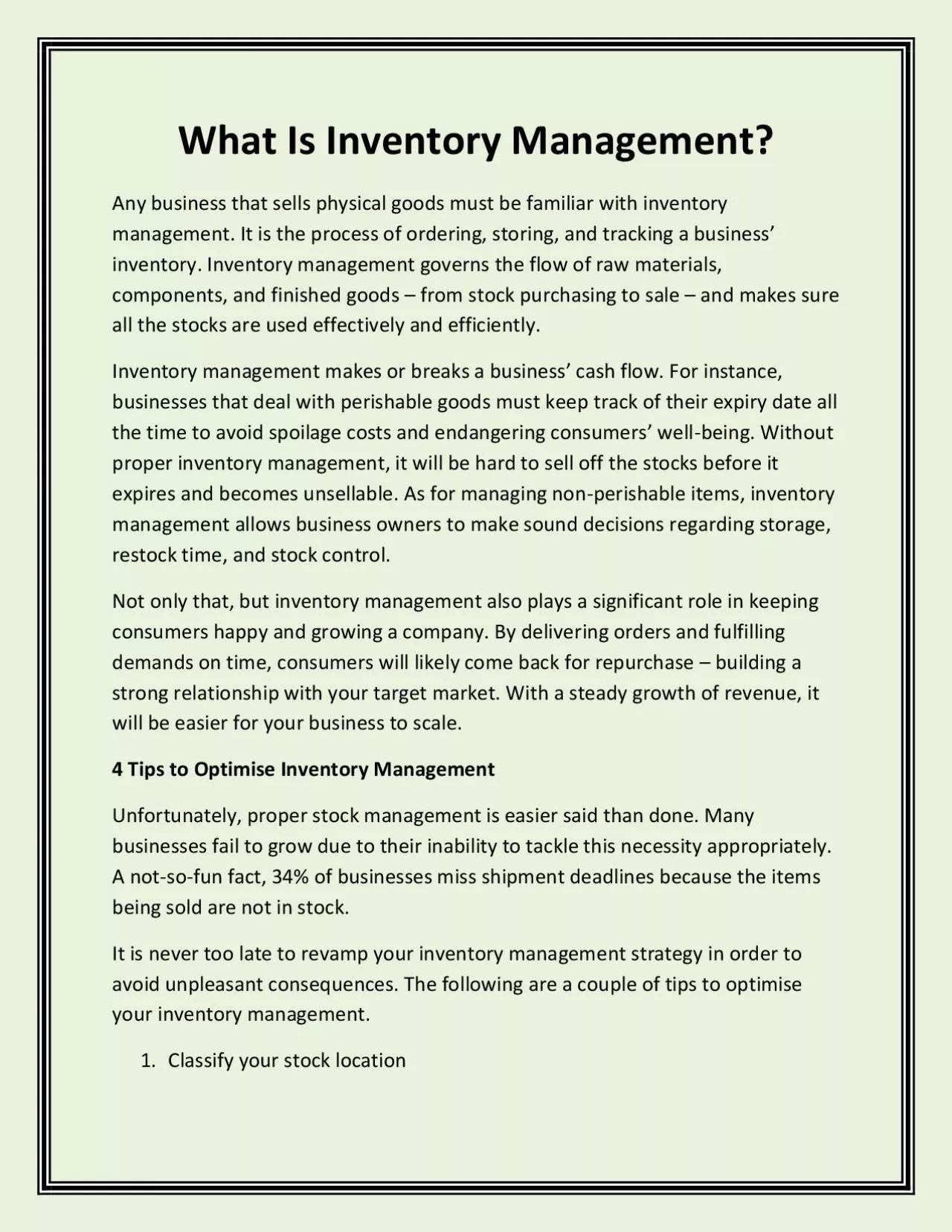/


Any business that sells physical goods must be familiar with inventory management ID: 925385
Download Pdf The PPT/PDF document "What Is Inventory Management?" is the property of its rightful owner. Permission is granted to download and print the materials on this web site for personal, non-commercial use only, and to display it on your personal computer provided you do not modify the materials and that you retain all copyright notices contained in the materials. By downloading content from our website, you accept the terms of this agreement.
What Is Inventory Management? Any business that sells physical goods must be familiar with inventory management. It is the process of ordering, storing, and tracking a business’ inventory. Inventory management governs the flow of raw materials, components, and finished goods – from stock purchasing to sale – and makes sure all the stocks are used effectively and efficiently. Inventory management makes or breaks a business’ cash flow. For instance, businesses that deal with perishable goods must k eep track of their expiry date all the time to avoid spoilage costs and endangering consumers’ well - being. Without proper inventory management, it will be hard to sell off the stocks before it expires and becomes unsellable. As for managing non - perishable items, inventory management allows business owners to make sound decisions regarding storage, restock time, and stock control. Not only that, but inventory management also plays a significant role in keeping consumers happy and growing a company. By delive ring orders and fulfilling demands on time, consumers will likely come back for repurchase – building a strong relationship with your target market. With a steady growth of revenue, it will be easier for your business to scale. 4 Tips to Optimise Inventory Management Unfortunately, proper stock management is easier said than done. Many businesses fail to grow due to their inability to tackle this necessity appropriately. A not - so - fun fact, 34% of businesses miss shipment deadlines because the items being so ld are not in stock. It is never too late to revamp your inventory management strategy in order to avoid unpleasant consequences. The following are a couple of tips to optimise your inventory management. 1. Classify your stock location Organising and storing your stocks by classification helps prevent the goods from getting mixed up. Doing so also makes finding and obtaining them easier and faster, increasing your workflow. Some of the most common parameters you can use to classify the goods include price, exp iry date, stock - keeping unit (SKU), item condition and age, and products that sell and don’t. You can create your own classification system using coloured stickers to maintain consistency and allow for easier identification. 1. Use a cloud - based retail inventory software One of the biggest advantages that a cloud - based retail inventory software offers is that it lets you accurately trace stocks at all stages and obtain real - time inf ormation for stock levels via remote access. Storing the data in digital format also eliminates storage issues and human errors during accounting data processes. Advstock Stock Inventories offers stocktaking apps for food and beverage businesses, stockta king apps for bars and clubs of all kinds, stocktaking apps for pharmacies , and stocktaking apps for convenience stores. Our small business stocktaking app is cloud - based, user - friendly, and easy to set up. If you are looking for a versatile stock and inventory app, you will be glad to hear that ours is available in Apple and Android app stores. 1. Plan for safety stock inventory Having an additional amount of stock in your inventor y prepares your business for the variability in market demand and trends. The surplus amount basically serves as a safety net to prevent stockouts, anticipate unexpected spikes in demand, and compensate for inaccurate market forecasts. 1. Do stocktake regular ly Checking the stock levels of your inventory periodically helps identify any discrepancies between your current inventory and the record from the previous stocktake. The process also serves as a safeguard against theft and fraud, minimising the risk of r evenue loss. With the help of our small business stocktaking app, you can carry out stocktakes at least once per month at minimum costs.